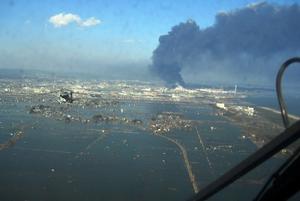Disaster in JapanOfficial: U.S. safe from Japanese radiation
U.S nuclear officials said that there was very little chance that harmful levels of radiation from Japan’s nuclear reactors would reach Hawaii or the west coast of the United States; the head of the Nuclear Regulatory Commission (NRC) also said nuclear plants in the United States were designed to withstand natural disasters like earthquakes and tsunamis; readings from radiation sensors placed on the west coast have not detected any increases in radiation levels and experts do not expect any increases; Japanese utilities have flooded two nuclear reactors with sea water in a desperate attempt to cool them down and prevent a meltdown; the NRC has dispatched two nuclear experts to Japan to assist with efforts to keep three damaged reactors from melting down

Flood and the Fukushima nuclear plant in the distance // Source: aljazeera.net
The head of the U.S. Nuclear Regulatory Commission (NRC), Gregory B. Jaczko, said there was very little chance that harmful levels of radiation from Japan’s nuclear reactors would reach Hawaii or the west coast of the United States.
“Based on the type of reactor design and the nature of the accident, we see a very low likelihood — really, a very low probability — that there’s any possibility of harmful radiation levels in the United States or in Hawaii or any other U.S. territories,” Jaczko said. Jaczko also sought to allay concerns about nuclear plants in the United States, saying that plants are “designed to withstand significant phenomena,” like earthquakes and tsunamis.
Readings from radiation sensors placed on the west coast confirm these statements.
According to Christine Stone, a spokesperson for the Oregon Public Health Division, “Readings do not show any increase in radiation, and no increases are expected.”
Stone said that radiation monitoring equipment in Oregon, Washington, Idaho, Alaska, as well as Canada have shown normal levels of radiation on Saturday and Sunday morning.
In a statement released on Sunday, the NRC said, “All the available information indicates weather conditions have taken the small releases from the Fukushima reactors out to sea away from the population. Given the thousands of miles between the two countries, Hawaii, Alaska, the U.S. Territories and the U.S. West Coast are not expected to experience any harmful levels of radioactivity.”
The NRC has dispatched two nuclear experts to Japan to assist with efforts to keep three damaged reactors from melting down.
Officials in Japan have flooded two nuclear reactors with sea water in a desperate attempt to cool them down and prevent a meltdown, after a powerful 8.9 magnitude earthquake destroyed electrical infrastructure that powered critical cooling systems.
Following a reactor explosion on Saturday, a second reactor exploded on Monday while a third exploded early Tuesday morning. Officials report that the containment units, which prevent catastrophic amounts of radiation from leaking out, are still intact.
Officials at the World Health Organization (WHO) said that there is minimal public health risk from the radiation leaks coming from Japan’s beleaguered reactors.
Gregory Hartl, a spokesman for the WHO, said, “From what we know at the moment on the radiation levels, the public health risk is minimal for Japan.”
He added, “That means that if someone is affected, there is no great risk.”
Nearly 200 Japanese residents were taken to the hospital with radiation exposure, but were only subjected to “low levels of radiation.”
According to Dr. David J. Brenner, the director of the Center for Radiological Research at Columbia University, the incident in Japan resembles the partial core meltdown of the nuclear reactor at Pennsylvania’s Three Mile Island reactor in 1979.
“At least as of now, what we’re looking at is rather more like Three Mile Island than Chernobyl,” said Dr. Brenner.
The accident at Three Mile Island released roughly a million times less radiation than the explosion at Chernobyl, where the entire reactor exploded and vaporized its radioactive fuel, leading to a dramatic increase in cases of thyroid cancer and leukemia.
The Three Mile Island reactor only suffered from a partial meltdown and did not have any noticeable impact on cancer rates.
Dr. Brenner said, “There is no evidence that anybody at all got sick, even decades later,” from the accident at Three Mile Island.
